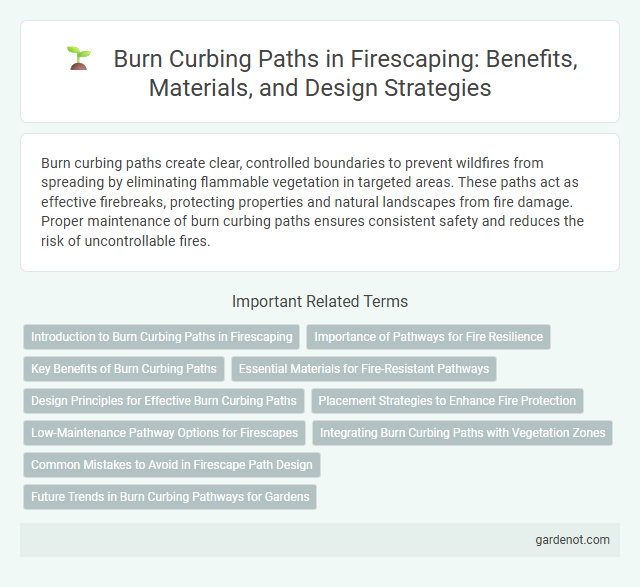Burn curbing paths create clear, controlled boundaries to prevent wildfires from spreading by eliminating flammable vegetation in targeted areas. These paths act as effective firebreaks, protecting properties and natural landscapes from fire damage. Proper maintenance of burn curbing paths ensures consistent safety and reduces the risk of uncontrollable fires.
Introduction to Burn Curbing Paths in Firescaping
Burn curbing paths in firescaping create strategic barriers that help control the spread of wildfires by removing combustible materials along property lines or garden edges. These cleared strips of land reduce fuel availability, allowing firefighters to manage and contain fire more effectively. Properly designed and maintained burn curbing paths are essential for enhancing fire resilience and protecting vulnerable landscapes.
Importance of Pathways for Fire Resilience
Burn curbing paths serve as critical firebreaks that slow or halt the advance of wildfires, protecting homes and landscapes by creating defensible spaces. Well-maintained pathways composed of non-flammable materials reduce fuel load, minimizing fire intensity and providing safe access routes for firefighting personnel. Strategic placement of these pathways enhances overall fire resilience by disrupting continuous vegetation and promoting landscape compartmentalization.
Key Benefits of Burn Curbing Paths
Burn curbing paths create effective firebreaks that significantly reduce wildfire spread by removing combustible materials and maintaining clear boundaries. These paths enhance safety by providing accessible routes for firefighters and emergency personnel to control and manage fires efficiently. Incorporating burn curbing paths into landscape design promotes long-term vegetation management, minimizing fire hazards around properties and natural areas.
Essential Materials for Fire-Resistant Pathways
Burn curbing paths require essential materials such as crushed stone, gravel, or decomposed granite to create fire-resistant barriers that prevent the spread of wildfire. Using non-combustible edging materials like metal, concrete, or brick enhances the durability of fire-resistant pathways. Proper installation involves compacting the base layer and maintaining a minimum width of 3 to 4 feet to ensure effective firebreaks around structures.
Design Principles for Effective Burn Curbing Paths
Burn curbing paths should be strategically designed with fire-resistant materials such as gravel, stone, or concrete to create effective firebreaks that prevent the spread of wildfires. The layout must ensure continuous, clear, and wide barriers around structures and vegetation, maintaining a minimum width of 3 to 5 feet depending on local fire risk. Incorporating gentle slopes and proper drainage enhances durability and reduces fire intensity by limiting combustible fuel accumulation along the path.
Placement Strategies to Enhance Fire Protection
Strategic placement of burn curbing paths around vulnerable property areas significantly reduces wildfire risk by creating defensible space that limits fuel availability. Utilizing natural landscape features and maintaining consistent widths of at least 3 to 5 feet optimizes fire break effectiveness, discouraging fire spread. Incorporating gravel, stone, or bare soil along these paths enhances heat resistance and directs fire away from structures.
Low-Maintenance Pathway Options for Firescapes
Burn curbing paths utilize fire-resistant materials like decomposed granite, gravel, or crushed stone to create low-maintenance pathways that reduce wildfire risk. These options require minimal watering and upkeep while effectively slowing fire spread around properties. Incorporating non-combustible surfaces in firescape design enhances safety and durability in fire-prone landscapes.
Integrating Burn Curbing Paths with Vegetation Zones
Integrating burn curbing paths with vegetation zones enhances fire prevention by creating strategically placed firebreaks that limit fuel continuity and reduce wildfire spread. Using fire-resistant plants and low-flammability materials along these paths supports the surrounding vegetation's health while maintaining effective barriers. Proper alignment of burn curbing paths with natural vegetation patterns also promotes ecological balance and minimizes environmental impact.
Common Mistakes to Avoid in Firescape Path Design
Burn curbing paths often suffer from common mistakes such as inadequate width, which limits safe fire access and evacuation routes. Using combustible materials like untreated wood chips or leaves instead of non-flammable gravel or stone increases fire risk along the path. Neglecting proper maintenance, including clearing debris and overgrown vegetation, undermines the effectiveness of burn curbing paths in fire prevention.
Future Trends in Burn Curbing Pathways for Gardens
Future trends in burn curbing pathways for gardens emphasize the integration of sustainable, fire-resistant materials such as recycled rubber and gravel, which enhance durability while minimizing environmental impact. Advancements in smart irrigation and moisture-retentive landscaping designs also reduce fire risk by maintaining optimal soil hydration around path perimeters. Embracing these innovations will improve fire safety and aesthetic appeal, aligning garden pathways with evolving ecological and regulatory standards.
Burn curbing path Infographic

 gardenot.com
gardenot.com